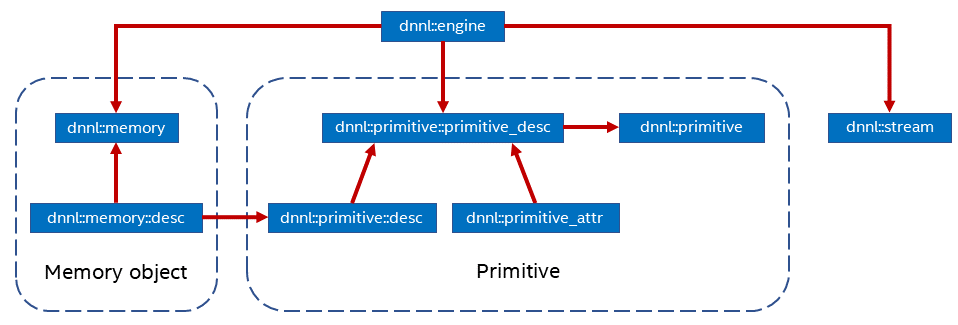In this page, an outline of the oneDNN programming model is presented, and the key concepts are discussed, including Primitives, Engines, Streams, and Memory Objects. In essence, the oneDNN programming model consists in executing one or several primitives to process data in one or several memory objects. The execution is performed on an engine in the context of a stream. The relationship between these entities is briefly presented in Figure 1, which also includes additional concepts relevant to the oneDNN programming model, such as primitive attributes and descriptors. These concepts are described below in much more details.

oneDNN is built around the notion of a primitive (dnnl::primitive). A primitive is a functor object that encapsulates a particular computation such as forward convolution, backward LSTM computations, or a data transformation operation. Additionally, using primitive attributes (dnnl::primitive_attr) certain primitives can represent more complex fused computations such as a forward convolution followed by a ReLU.
The most important difference between a primitive and a pure function is that a primitive can store state.
One part of the primitive’s state is immutable. For example, convolution primitives store parameters like tensor shapes and can pre-compute other dependent parameters like cache blocking. This approach allows oneDNN primitives to pre-generate code specifically tailored for the operation to be performed. The oneDNN programming model assumes that the time it takes to perform the pre-computations is amortized by reusing the same primitive to perform computations multiple times.
The mutable part of the primitive’s state is referred to as a scratchpad. It is a memory buffer that a primitive may use for temporary storage only during computations. The scratchpad can either be owned by a primitive object (which makes that object non-thread safe) or be an execution-time parameter.
Engines (dnnl::engine) is an abstraction of a computational device: a CPU, a specific GPU card in the system, etc. Most primitives are created to execute computations on one specific engine. The only exceptions are reorder primitives that transfer data between two different engines.
Streams (dnnl::stream) encapsulate execution context tied to a particular engine. For example, they can correspond to OpenCL command queues.
Memory objects (dnnl::memory) encapsulate handles to memory allocated on a specific engine, tensor dimensions, data type, and memory format – the way tensor indices map to offsets in linear memory space. Memory objects are passed to primitives during execution.
oneDNN has multiple levels of abstractions for primitives and memory objects in order to expose maximum flexibility to its users.
On the logical level, the library provides the following abstractions:
| Abstraction level | Memory object | Primitive objects |
|---|---|---|
| Logical description | Memory descriptor | Operation descriptor |
| Intermediate description | N/A | Primitive descriptor |
| Implementation | Memory object | Primitive |
Memory objects are created from the memory descriptors. It is not possible to create a memory object from a memory descriptor that has memory format set to dnnl::memory::format_tag::any.
There are two common ways for initializing memory descriptors:
Memory objects can be created with a user-provided handle (a void * on CPU), or without one, in which case the library will allocate storage space on its own.
The sequence of actions to create a primitive is: